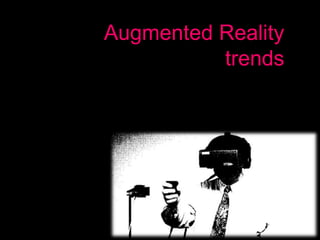Augumented Reality trends
- 1. Augmented Reality Trends
- 2. History  From 1957 as science application  90’th as complex engineering software for modeling and 3D graphics  1999 ARToolKit as a birth of modern AR
- 3. Principles ÔÇß video capture tracking of the real world to combine with the interaction of virtual objects Needed: 1. Reality 2. Marker 3. Screen 4. AR logic and graphics
- 4. Usage in marketing ÔÇß Visualization of product features ÔÇß Consumer engagement ÔÇß Gamification ÔÇß Additional information placement
- 5. Customer journey  Awareness – through viral effect  Consideration – WOW factor attention  Inquiry – online product evaluation  Purchase – POS installation  Retention – follow-up attention
- 6. Typical Cases ÔÇß DOOH Interactive Installations ÔÇß Web projects ÔÇß Mobile Apps
- 7. Mobile AR 1. Mobile device 2. Application 3. Print as a marker: ÔÇß Magazine and newspaper ÔÇß Indoor and outdoor prints ÔÇß Billboards
- 8. Possible limitations ÔÇß Mobile Platform ÔÇß Screen Size ÔÇß Graphic Complicity ÔÇß Internet Connection ÔÇß Social acceptance
- 9. Cases ÔÇß http://vimeo.com/50638914 WonderBra ÔÇß http://vimeo.com/38579277 Coffe House ÔÇß http://vimeo.com/32153441 VW ÔÇß http://vimeo.com/33790882 Lacta ÔÇß http://www.youtube.com/watch?v=QQ8HNXtl7jQ IKEA ÔÇß http://www.youtube.com/watch?v=2pjpQRiIgTs Viking
- 10. Futurism “The next big thing in AR will still be via smartphones, and we will see developments in the field of image, object, color recognition. <…> Also, location layers and image recognition might merge to give users a more wholesome experience. In terms of beyond mobile, I do believe an AR eye-lens and glasses will evolve, but the gear needs to be lightweight, attractive and comfortable to wear.”
- 11. Alex Vyatkin Account Director 2Nova Interactive +79216577888 alex.vyatkin@2nova.ru











